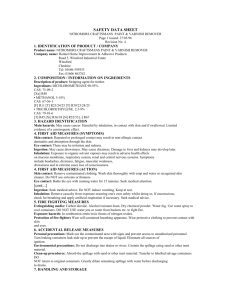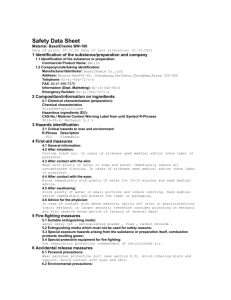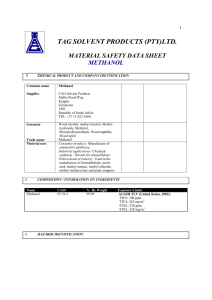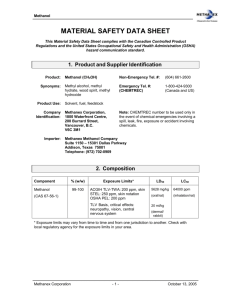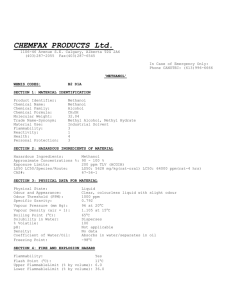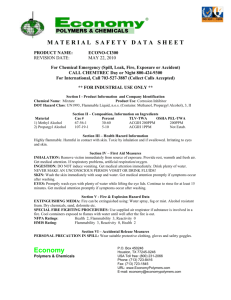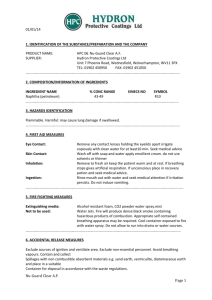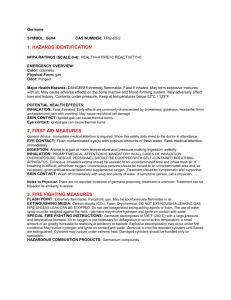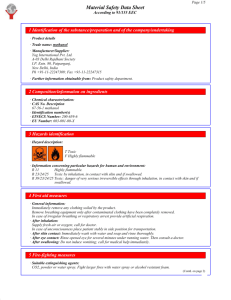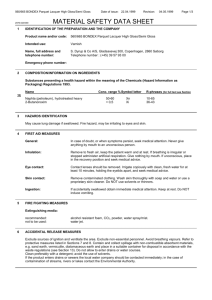ProSil SR 108 for MBM
advertisement
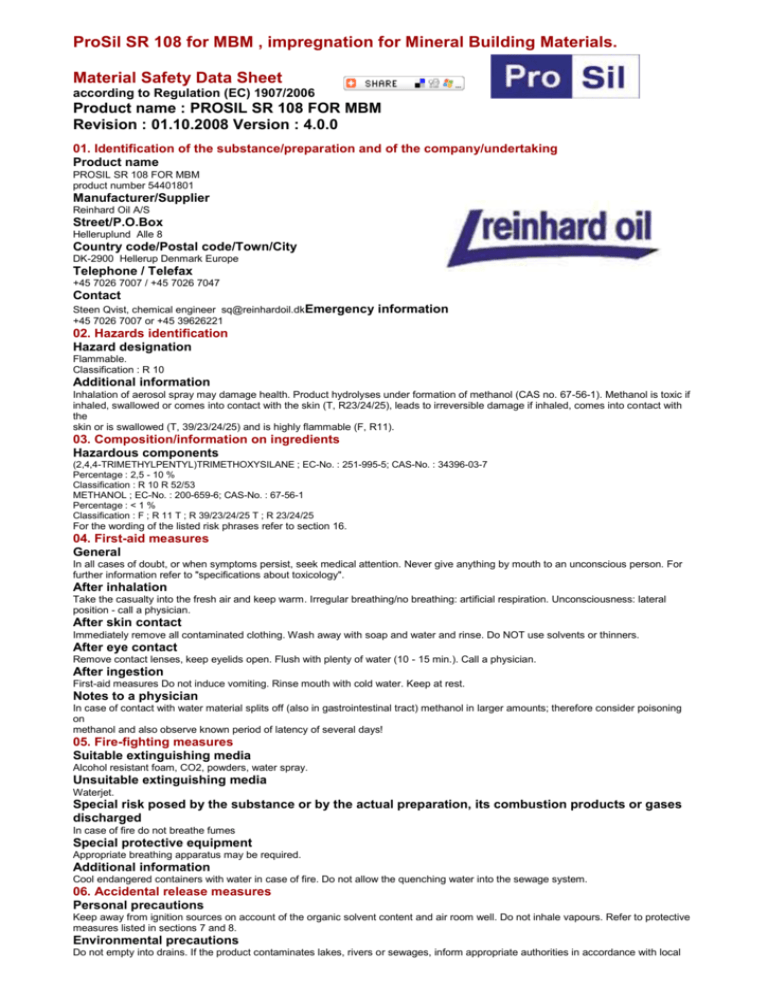
ProSil SR 108 for MBM , impregnation for Mineral Building Materials. Material Safety Data Sheet according to Regulation (EC) 1907/2006 Product name : PROSIL SR 108 FOR MBM Revision : 01.10.2008 Version : 4.0.0 01. Identification of the substance/preparation and of the company/undertaking Product name PROSIL SR 108 FOR MBM product number 54401801 Manufacturer/Supplier Reinhard Oil A/S Street/P.O.Box Helleruplund Alle 8 Country code/Postal code/Town/City DK-2900 Hellerup Denmark Europe Telephone / Telefax +45 7026 7007 / +45 7026 7047 Contact Steen Qvist, chemical engineer sq@reinhardoil.dkEmergency +45 7026 7007 or +45 39626221 information 02. Hazards identification Hazard designation Flammable. Classification : R 10 Additional information Inhalation of aerosol spray may damage health. Product hydrolyses under formation of methanol (CAS no. 67-56-1). Methanol is toxic if inhaled, swallowed or comes into contact with the skin (T, R23/24/25), leads to irreversible damage if inhaled, comes into contact with the skin or is swallowed (T, 39/23/24/25) and is highly flammable (F, R11). 03. Composition/information on ingredients Hazardous components (2,4,4-TRIMETHYLPENTYL)TRIMETHOXYSILANE ; EC-No. : 251-995-5; CAS-No. : 34396-03-7 Percentage : 2,5 - 10 % Classification : R 10 R 52/53 METHANOL ; EC-No. : 200-659-6; CAS-No. : 67-56-1 Percentage : < 1 % Classification : F ; R 11 T ; R 39/23/24/25 T ; R 23/24/25 For the wording of the listed risk phrases refer to section 16. 04. First-aid measures General In all cases of doubt, or when symptoms persist, seek medical attention. Never give anything by mouth to an unconscious person. For further information refer to "specifications about toxicology". After inhalation Take the casualty into the fresh air and keep warm. Irregular breathing/no breathing: artificial respiration. Unconsciousness: lateral position - call a physician. After skin contact Immediately remove all contaminated clothing. Wash away with soap and water and rinse. Do NOT use solvents or thinners. After eye contact Remove contact lenses, keep eyelids open. Flush with plenty of water (10 - 15 min.). Call a physician. After ingestion First-aid measures Do not induce vomiting. Rinse mouth with cold water. Keep at rest. Notes to a physician In case of contact with water material splits off (also in gastrointestinal tract) methanol in larger amounts; therefore consider poisoning on methanol and also observe known period of latency of several days! 05. Fire-fighting measures Suitable extinguishing media Alcohol resistant foam, CO2, powders, water spray. Unsuitable extinguishing media Waterjet. Special risk posed by the substance or by the actual preparation, its combustion products or gases discharged In case of fire do not breathe fumes Special protective equipment Appropriate breathing apparatus may be required. Additional information Cool endangered containers with water in case of fire. Do not allow the quenching water into the sewage system. 06. Accidental release measures Personal precautions Keep away from ignition sources on account of the organic solvent content and air room well. Do not inhale vapours. Refer to protective measures listed in sections 7 and 8. Environmental precautions Do not empty into drains. If the product contaminates lakes, rivers or sewages, inform appropriate authorities in accordance with local regulations. Methods for cleaning up/collecting Contain and collect spillage with non-combustible absorbent materials, e.g. sand, earth, vermiculite, diatomaceous earth and place in container for disposal according to local regulations (see section 13). Clean preferabily with a detergent; avoid use of solvents. 07. Handling and storage Information for safe handling Prevent the creation of inflammable or explosive concentrations of vapour in air and avoid vapour concentrations higher than the OEL (=Occupational Exposure Limit). Additionally, the product should only be used in areas from which all naked lights and other sources of ignition have been excluded. Avoid contact with skin and eyes. Do not inhale the vapour. Do not eat or drink during work - no smoking. Comply with the health and safety at work laws. Information about protection against explosions and fires Vapours are heavier than air and may spread along floors. Vapours may form explosive mixtures with air. No sparking tools should be used. Requirements to be met by storerooms and containers Electrical equipment should be pr.tected to the appropriate standard. Floors should be of the conducting type. Keep container tightly closed. Never use pressure to empty: container is not a pressure vessel. No smoking. Prevent unauthorized access. Containers which are opened must be carefully resealed and kept upright to prevent leakage. Information about separation of incompatible products Keep away from oxidizing agents, from strongly alkaline and strongly acid materials. Further information about storage conditions Always keep in containers of same material as the original one. See also instructions on the label. Avoid heating and direct sunlight. Keep away from ignition sources - No smoking. Storage class (VCI) : 3 08. Exposure controls/personal protection Additional information about engineering measures Provide adequate ventilation. Where reasonably practicable this should be achieved by the use of local exhaust ventilation and good general extraction. If these are not sufficient to maintain concentrations of particulates and solvent vapour below the OEL (=Occupational Exposure Limit) , suitable respiratory protection must be worn. Personal protective equipment Respiratory protection If workplace limits are exceeded, a gas mask approved for this purpose must be worn. Fresh air masks are recommended, or combination filters A2-P2 for works of short duration. Hand protection Use protective gloves. Eye protection Use tightly fitting safety glasses. 09. Physical and chemical properties Relevant safety data Physical state : liquid Odour : Characteristic. Colour : Opal. Boiling point / range : ( 1013 hPa ) > 190 °C Flash point : 44 °C Vapour pressure : ( 50 °C ) < 1000 hPa Density : ( 20 °C ) ca. 1,1 g/cm3 Solubility in water : ( 20 °C ) insoluble Viscosity : ( 20 °C ) ca. 20 mPa.s 10. Stability and reactivity Conditions to avoid moisture Materials to avoid Reacts with: water , basic substances and acids . Reaction causes the formation of: methanol . Hazardous decomposition products Under the effect of humidity, water and protic agents: methanol . The following applies for the silicone content of the substance: Measurements have shown the formation of small amounts of formaldehyde at temperatures above about 150 °C (302 °F) through oxidation. 11. Toxicological information There are no data available on the preparation itself. The product was classified in toxicological terms on the basis of the results of the calculation procedure outlined within General Directive on Preparations (1999/45/EC). Prolonged inhalation of vapours in high concentrations may lead to headache, giddiness and nausea. Inhalation/eye contact: in high concentrations irritating to the mucous membranes, narcotic effect and influence on power of reaction and loss of coordination possible. Skin and eye contact: frequent and long lasting contact may cause irritation and skin inflammation. Eye contact: irritation. Additional toxicological information Product(s) of hydrolysis: Attention! Product may hydrolyse in gastro-intestinal tract and produce methanol. According to literature methanol (67-56-1) irritates mucuous membranes, has skin drying and narcotic effects up to coma or death. Absorption by the skin is possible. Possibility of damage to heart, kidneys, liver and optic nerves (blindness) over a period of time. 12. Ecological information Do not empty into waters or drains. 13. Disposal considerations In accordance with local official regulations. 14. Transport information Land transport ADR/RID Remarks Not regulated in Class 3 - ADR/RID 2.2.3.1.1 NOTE 1 - Substance does not sustain combustion! Maritime transport IMDG/GGVSea Remarks Not regulated in Class 3 - IMDG 2.3.1.3 - Substance does not sustain combustion! Air transport ICAO-TI and IATA-DGR Remarks Not regulated in Class 3 - IATA 3.3.1.3 / ICAO 3.1.3 - Substance does not sustain combustion! 15. Regulatory information Classification according to EC directives R-phrases 10 Flammable. S-phrases 35 This material and its container must be disposed of in a safe way. National regulatory information Water pollution classification Class : - according VwVwS 16. Other information The details in this material safety data sheet satisfy national and EC legislation. We have no knowledge or control over the user´s working conditions however. The user is responsible for the observance of all required statutory provisions. Further information Relevant changes 07. Information about separation of incompatible products . 08. References to the thresholds R-Phrases of components 10 Flammable. 11 Highly flammable. 23/24/25 Toxic by inhalation, in contact with skin and if swallowed. 39/23/24/25 Toxic: danger of very serious irreversible effects through inhalation, in contact with skin and if swallowed. 52/53 Harmful to aquatic organisms, may cause long-term adverse effects in the aquatic environment. These data are based on our present knowledge. However, they shall not constitute a guarantee for any specific product features and shall not establish a legally valid contractual relationship.
